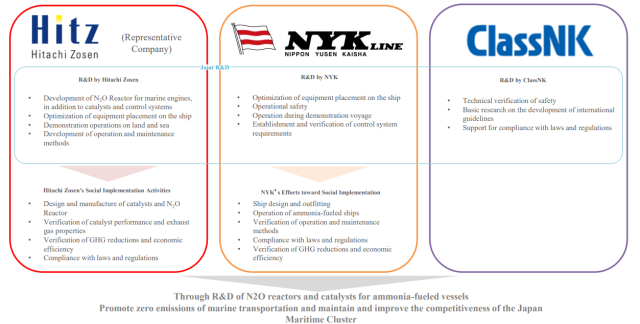Japanese government funding for N2O removal system for ammonia-fueled ships
By Geofrey Njovu on April 23, 2024

Click to enlarge. Roles of the partner organisations in the N2O removal reactor project. Source: NYK Line.
Hitachi Zosen Corporation and Nippon Yusen Kabushiki Kaisha (NYK) have announced that their joint proposal to develop a catalyst-based reactor for N2O removal from ammonia fueled 2-stroke engines has been awarded funding by Japan’s New Energy and Industrial Technology Development Organization (NEDO) as part of the Green Innovation Fund Projects (GI Fund Projects).
Set to be implemented between 2024 and 2027, the project is focused on developing a catalytic removal system (N2O Reactor) for nitrous oxide (N2O) emitted from ammonia fuel combustion. A by-product of ammonia combustion, N2O has a global warming potential that is over two orders of magnitude (about 300 times) larger than that of CO2, making its removal crucial to the realisation of ammonia-fueled ships.
With extensive expertise in catalyst technology development, Hitachi will be responsible for catalyst and equipment development in this project. It will also be in charge of equipment layout optimisation.
NYK will install the developed N2O Reactor on an ammonia-fueled gas carrier scheduled for delivery in November 2026. It will also run demonstrations focussed on safety and performance testing. Lastly, classification society ClassNK will conduct safety verification of the reactors and basic research on the development of international guidelines.
Low N2O ammonia combustion: a priority
NOX reduction from combustion is a crucial factor in the use of ammonia as a maritime fuel. Following the recent, successful sailing of its ammonia-powered Green Pioneer, Fortescue intends to focus on post-combustion N2O treatment.
In order to comply with the IMO’s Tier 3 Regulations that entered into force in 2016, SCR technology has been deployed onboard vessels, reducing NOX emissions by at least 80% compared with unmitigated combustion. The use of SCR technology to ensure mitigation of emissions from ammonia-fueled engines is relatively new, but is based on existing catalysts, equipment, and integrated systems. In a 2023 report by the Mærsk Mc-Kinney Møller Center, the authors found that vessel owners and engine developers were highly confident that ammonia-fueled vessel emission challenges would be met.